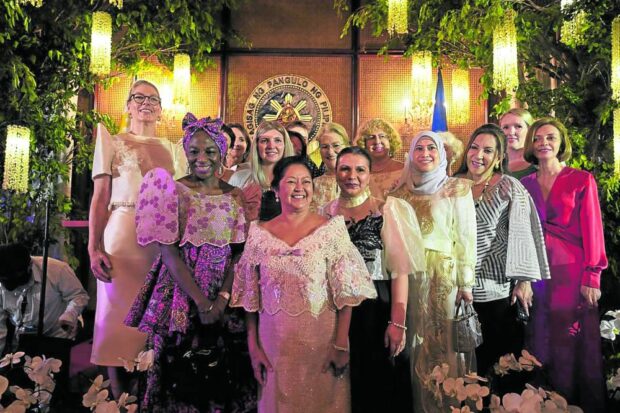
It was hard to picture the stately rooms, the warm glow of its ornate Czech crystal chandeliers now illuminating its grandeur—from the thick carpeted length of the Reception Hall to the sawali wood-carved panels on the ceiling, the walls adorned with portraits of presidents past, leading to the equally grand Rizal Ceremonial Hall, its carved Betis chandeliers floating above—as “dark and gloomy,” as a colleague who was an occasional visitor here during the Duterte administration described what the place used to be on those visits.
Former President Duterte was famous for shunning social events, such that these halls were rarely used for dressy occasions, as the one that was being held on this evening. The current occupants are evidently more at home in hosting such affairs.
The refreshed look of the centuries-old Malacañang Palace is attributed to interior designer Jonathan Matti. The palace was built in 1750 as the summer house of a Spanish aristocrat, and was sold to the government after his death in 1825. It became the official residence of Philippine presidents in 1935.
It was a drizzly late afternoon when we arrived at Malacañang Palace for the President’s vin d’ honneur (pronounced van-daw-nur) and 125th anniversary celebration of Philippine Independence on Monday, and as we walked up the red-carpeted grand staircase, bedecked with flowers for the occasion, and trudged our way onto the Ceremonial Hall beyond, we couldn’t help but feel how surreal it was to be there.
We’re no tyro, but it was our first time to ever step onto Malacañang, both as a civilian and a journo. As we would find out soon enough, we were not alone, as we met our contemporaries in the lifestyle beat, who expressed similar surprise at being invited. It was all our first time to cover a Malacañang event.
Sen. Loren Legarda, herself a former journalist, expressed to us her amazement that the lifestyle press was invited. The vin d’honneur, literally wine of honor or wine reception, is an event whose guest list is usually confined to foreign diplomats and select government officials, and traditionally held in the New Year and on June 12.
Select fashion designers were also present, mingling with business leaders.
Promoting PH fashion
But as soon as the President made his ceremonial toast, the agenda became clear: the event was also in support of first lady Liza Araneta-Marcos’ programs, and in this instance, it’s promoting Philippine fashion.
The office of the first lady had paired up the women foreign envoys with Filipino designers to make them each a national dress for the evening. And they did, in its varied permutations.
Just days prior, Araneta-Marcos unveiled the second “Likha” event at SM Aura, celebrating traditional Filipino crafts and weaves.
“The ladies of the diplomatic corps put a new spin on our national costume, and with the help of some of our local designers, they have created a wonderful spectacle,” said the President in his welcome remarks.
“So, the gentlemen of the diplomatic corps, after this evening, we’re going to have to up our game,” added the President, who wore a barong by the late Pepito Albert, to applause.
The First Lady wore a lacey off-shoulder maria clara dress adorned with pink ribbons by Paul Cabral, who’s no stranger to dressing up residents of the Palace, having made clothes for Presidents Corazon Aquino, Benigno Aquino III and Gloria Macapagal-Arroyo.
Diplomats in Filipiniana
Another Palace old-timer, JC Buendia, was present, this time as designer of Sweden Ambassador Annika Gunilla Thurborg, who was radiant in a stylized barong with bell sleeves.
Avant-garde designer Joey Samson took a unique route and merged the culture and vibrant sensibility of Nigeria Ambassador Folakemi Ibidunni Akinleye with Filipino design, in her terno top with stylized tapis of tiered flounces. Samson used 100-percent cotton kitenge or Ankara fabric, a textile made in the Nigerian capital.
“The method of producing African print fabric is called batik, a wax-resist dyeing technique. The design and colors look the same on both sides of the fabric. Its durability, affordability and comfort make it one of the most attractive fabrics in Africa,” the designer explained.
Randy Ortiz, who used to make dresses for Araneta-Marcos during her lawyering days, dressed Venezuela Ambassador Capaya Rodriguez Gonzales. She wore a simple organdy kimona top with terno sleeves, adorned with floral embroidery appliqués, and paired with a hot-pink draped skirt.
Ortiz also made the inabel terno dress of the svelte Tourism Secretary Christina Frasco.
Dennis Lustico dressed the amiable Hungary Ambassador Dr. Titanilla Toth, in a hand-embroidered black piña terno with built-in pañuelo.
Lulu Tan Gan’s muse was Brunei Darussalam Ambassador Megawati Dato Paduka Haji Manan, who wore a Filipino-Bruneian-inspired piña barong ensemble with gold embroidery.
“It was a classic gown wherein both traditions were considered,” Tan Gan told Lifestyle. “It was important that my ambassador be comfortable in both the fit and the design. Finding the right deign with her veil intact, right motif—getting close to the repetitive motif of the songket fabric—and the right tone of gold embroidery were considered.”
Puey Quiñones, a Marcos favorite, made a traditional off-white terno dress for France Ambassador Michele Boccoz. It had a flouncy petaled skirt inspired by a vintage Dior design and an Imelda Marcos dress, he told Lifestyle.
Another Marcos favorite, Avel Bacudio, made the dress of Colombia Ambassador Marcela Ordonez Fernandez. Bacudio also designed the barong of the President’s son, Rep. Sandro Marcos.
Germany Ambassador Anke Reiffenstuel wore an appliquéd terno top with a matching pencil skirt by Jun Escario.
Ivarluski Aseron designed a green terno dress for Australian Embassy’s charges d’affaires and deputy head of mission Dr. Moya Collett, while Milka Quin made the dress of Netherlands Ambassador Maria Alfonsa Magdalena Geraedts.
“We’re very fortunate to be able introduce our indigenous clothing culture to the vin d’honneur,” said Tan Gan.